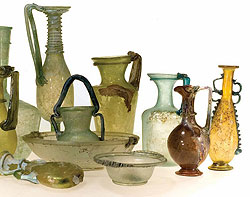The Glass Panel from Caesarea is on Exhibit at the Metropolitan Museum of Art in New York

Photographic credit: Niki Davidov, courtesy of the Israel Antiquities Authority.
In light of the exhibit of the glass panel from Caesarea at the Metropolitan Museum of Art after it was displayed at the De Young Museum in San Francisco, Yael Gurin-Rosen, Head of the Ancient Glass Department of the Israel Antiquities Authority, was invited to both museums to lecture on glass artifacts from Israel. The title of the lecture is: “From the Furnace Fire to the Emperor’s Court – Ancient Glass from the Holy Land”
Israel was an important center for the production of glass in antiquity. Already in the Early Roman period there were stories of the discovery of glass material are associated with the Belus River valley, which is the Na’aman River that flows south of the city of Akko. The first evidence of the invention of glassblowing was found in the Jewish Quarter of Jerusalem, in a layer of fill inside a miqve that was overlain with the paving stones of the Herodian street. This evidence proves that glassblowing was invented in the second half of the first century BCE. From the first century CE onward, the glass industry flourished in Israel. Small workshops supplied the glassware that was used locally and in every period we see different forms of tableware, cosmetics vessels and lamp vessels.
The local vessel industry relied on a highly developed industry of raw glass production; the height of the manufacture of raw material was reached at the end of the Byzantine period and the beginning of the Early Islamic period. At that time there were factories in Israel that produced hundreds of tons of glass that was primarily intended for export throughout the Byzantine Empire. The raw glass that was produced in the country found its way to artisans’ workshops all over the Mediterranean Sea and it is quite possible that the glass was also used by craftsmen in the imperial court in Constantinople (what is today Istanbul).
The thriving glass vessel industry, the workshops and their beautiful products will be presented in the lecture.
In addition, the lecture will also focus on the gold-glass panel, which is currently on display in a special exhibit at the Metropolitan Museum of Art in New York. It was previously shown in the De Young Museum in San Francisco as part of an exhibit of special finds from excavations in the Holy Land.
This object is unique and there is no other one like it in the world. The panel was discovered in the winter of 2005 during a salvage excavation that was conducted by Dr. Sefi Porath, on behalf of the Israel Antiquities Authority in Caesarea when the “Bird Mosaic” was being prepared for presentation to the general public. The panel dates to the latter part of the Byzantine period (the end of the sixth century and the beginning of the seventh century CE). The conservation work on the panel was carried out by the Conservation Department together with the Ancient Glass Department of the Israel Antiquities Authority and was made possible through the generosity of Tom and Margot Pritzker.
The panel (103 x 103 cm) is composed of small tiles made of gold-glass and mosaic glass that were incorporated in an intricate geometric pattern. Some of the tiles are decorated with a cross pattern and others are adorned with a flower pattern (rosette). This special object may have been used as a table or as an altar in a church. The artifact from Caesarea resembles the description of a glittering altar that is mentioned in historical sources. That particular altar was in the Hagia Sophia Church (Holy Wisdom) in Constantinople; hence there is another connection to the imperial court.
In addition to these lectures a roundtable discussion on the subject of gold-glass in antiquity will take place in New York in which Christopher Lightfoot a curator at the Metropolitan Museum; David Whitehouse, director of the Corning Glass Museum; and Yael Gurin-Rosen of the Israel Antiquities Authority will speak.
Additional Articles ...